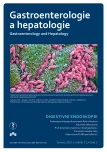First experience with probe-based confocal laser endomicroscopy (pCLE) in biliodigestive endoscopy
Authors:
B. Lőrincz 1; R. Husťak 2–4; V. Bošák 4; M. Kollár 5; J. Špičák 5; J. Martínek 2,5
Authors‘ workplace:
Cytopathos, spol. s r. o, Bratislava, Slovenská republika
1; Gastroenterologická a endoskopická ambulancia, Interná klinika FZaSP TU a FN Trnava, Slovenská republika
2; 1. LF UK v Praze
3; Katedra laboratórnych vyšetrovacích metód v zdravotníctve, FZaSP TU v Trnave, Slovenská republika
4; Klinika hepatogastroenterologie, Transplantcentrum, IKEM, Praha
5
Published in:
Gastroent Hepatol 2017; 71(3): 220-223
Category:
Digestive Endoscopy: Video-Case Report
doi:
https://doi.org/10.14735/amgh2017220
Overview
In routine clinical situations it is extremely complicated to distinguish benign lesions from malignant biliary lesions. Endoscopic techniques (endoscopic retrograde cholangiopancreatography, endoscopic ultrasonography), as well as non-invasive imaging methods (magnetic resonance cholangiopancreatography, computerised tomography – CT, ultrasonography or endoscopic ultrasonography) often cannot determine the nature of findings in the biliopancreatic system. Indeterminate stenoses pose a major diagnostic challenge. Oral cholangioscopy (SpyGlass) in both the first and the second (digital) generation helped improve the diagnostic accuracy of findings, especially through direct inspection with the addition of targeted biopsies. With the development of new methods, probe-based laser endomicroscopy (pCLE) has been used in the market for the last 10 years and, combined with endoscopic retrograde cholangiopancreatography, it has broadened the possibilities of diagnostic yield in resolving indeterminate biliary route stenoses. We present the case of the first clinical application of the approach combining oral cholangioscopy and pCLE in the Czech and Slovak Republics in a patient with suspected stenosis of the extrahepatic bile ducts.
Key words:
probe-based confocal laser endomicroscopy Cellvizio – cholangioscopy SpyGlass™ DS – indeterminate stenosis – endoscopic retrograde cholangiopancreatography
The authors declare they have no potential conflicts of interest concerning drugs, products, or services used in the study.
The Editorial Board declares that the manuscript met the ICMJE „uniform requirements“ for biomedical papers.
Submitted:
11. 4. 2017
Accepted:
29. 5. 2017
Sources
1. Keane MG, Marlow NJ, Pereira SP. Novel endoscopic approaches in the diag-nosis and management of biliary strictures. F1000Prime Rep 2013; 5: 38. doi: 10.12703/P5-38.
2. Caillol F, Filoche B, Gaidhane M et al. Refined probe-based confocal laser endomicroscopy classification for biliary strictures: the Paris Classification. Dig Dis Sci 2013; 58 (6): 1784–1789. doi: 10.1007/s10620-012-2533-5.
3. Bowlus CL, Olson KA, Gershwin ME. Evaluation of indeterminate biliary strictures. Nat Rev Gastroenterol Hepatol 2016; 13 (1): 28–37. doi: 10.1038/nrgastro.2015.182.
4. Meining A, Chen YK, Pleskow D et al. Direct visualization of indeterminate pancreaticobiliary strictures with probe-based confocal laser endomicroscopy: a multicenter experience. Gastrointest Endosc 2011; 74 (5): 961–968. doi: 10.1016/j.gie.2011.05.009.
5. Fugazza A, Gaiani F, Carra MC et al. Confocal laser endomicroscopy in gastrointestinal and pancreatobiliary diseases: a systematic review and meta-analysis. Biomed Res Int 2016; 2016: 4638683. doi: 10.1155/2016/4638683.
6. Kahaleh M, Giovannini M, Jamidar P et al. Probe-based confocal laser endomicroscopy for indeterminate biliary strictures: refinement of the image interpretation classification. Gastroenterol Res Pract 2015; 2015: 675210. doi: 10.1155/ 2015/675210.
7. Wallace M, Lauwers GY, Chen Y et al. Miami classification for probe-based confocal laser endomicroscopy. Endoscopy 2011; 43 (10): 882–891. doi: 10.1055/s-0030-1256 632.
8. Chauhan SS, Dayyeh BK, Bhat YM et al. Confocal laser endomicroscopy. Gastro-intest Endosc 2014; 80 (6): 928–938.
Labels
Paediatric gastroenterology Gastroenterology and hepatology SurgeryArticle was published in
Gastroenterology and Hepatology

2017 Issue 3
Most read in this issue
- Rifaximin
- Guidelines of the IBD working group of the Slovak Gastroenterology Society on the management of ulcerative colitis
- Colonic decompression in daily practice
- Difficult diagnostics and serious biliary complications of liver echinococcosis
